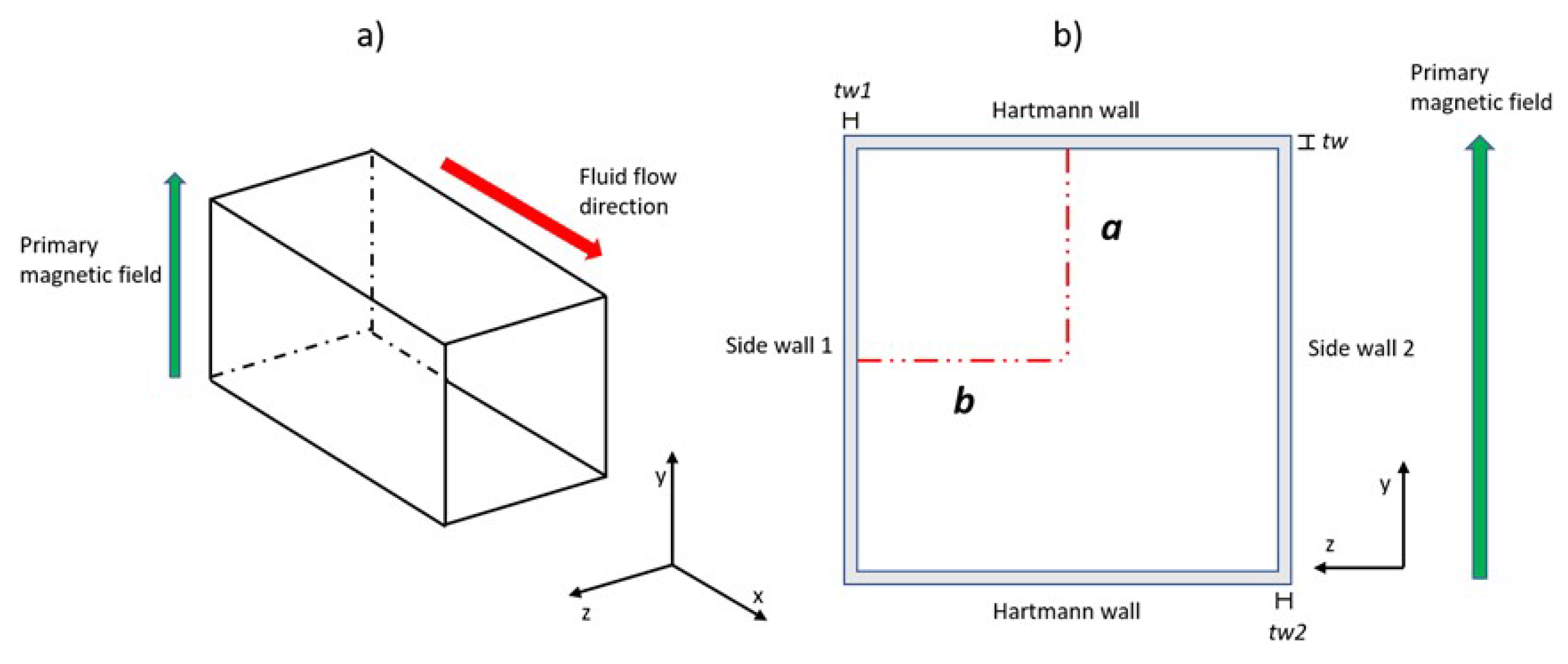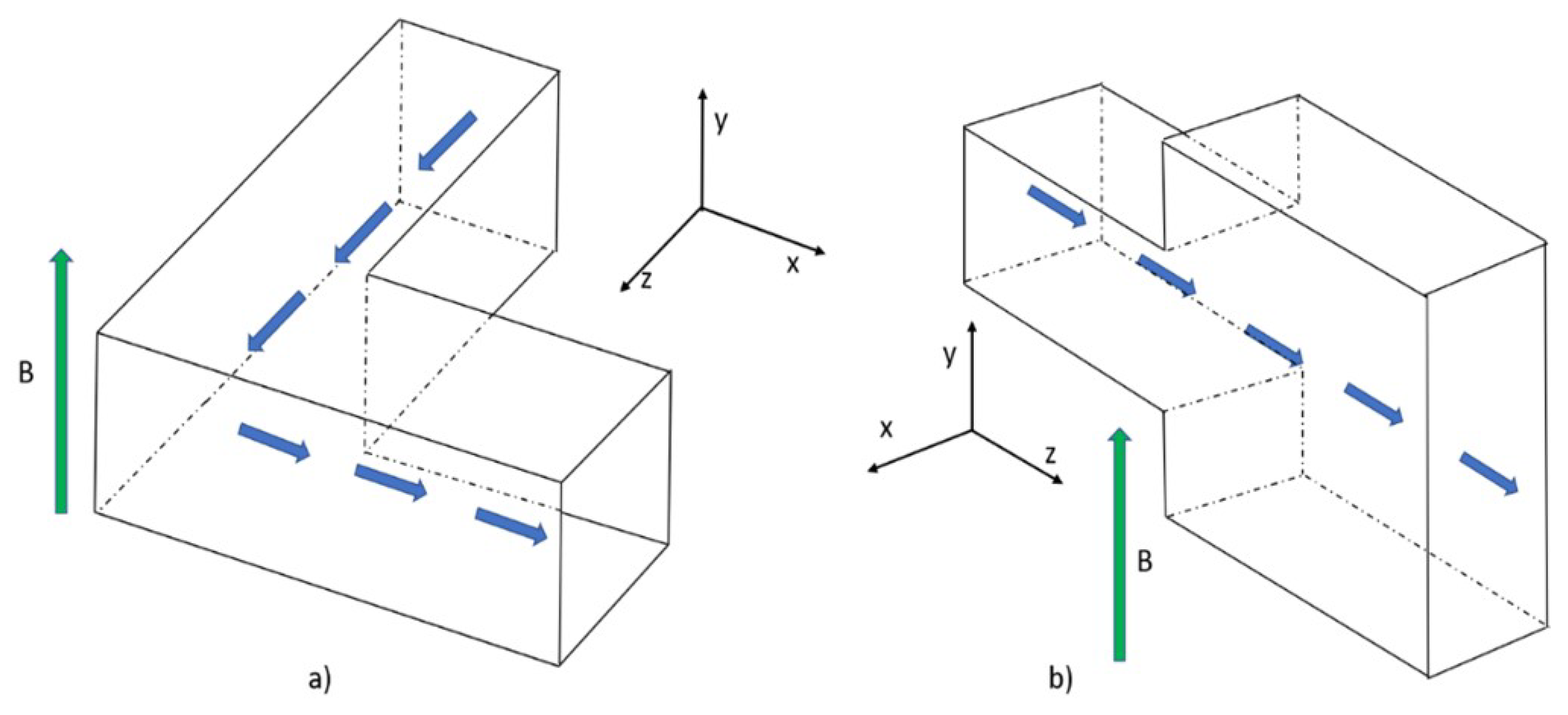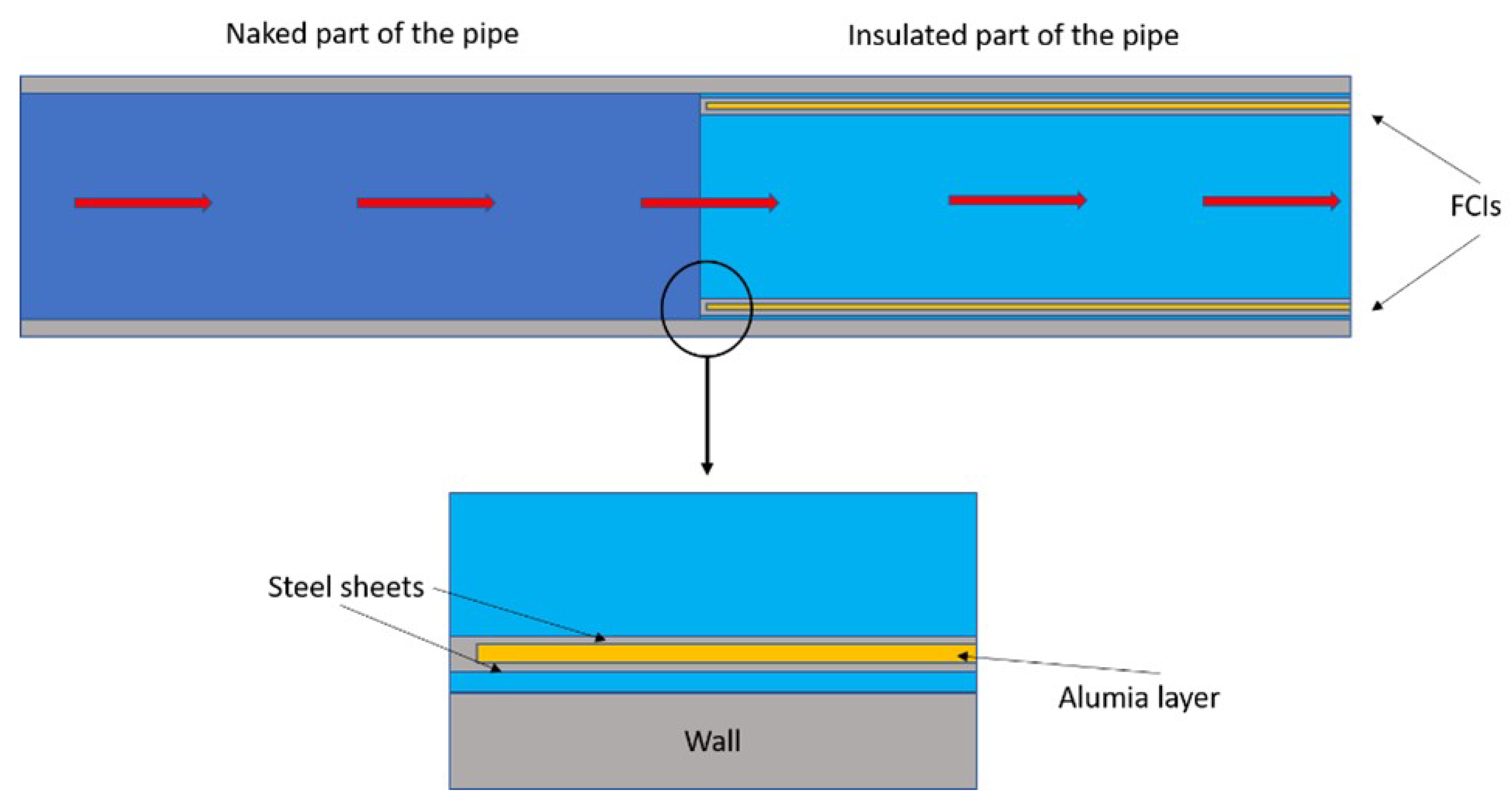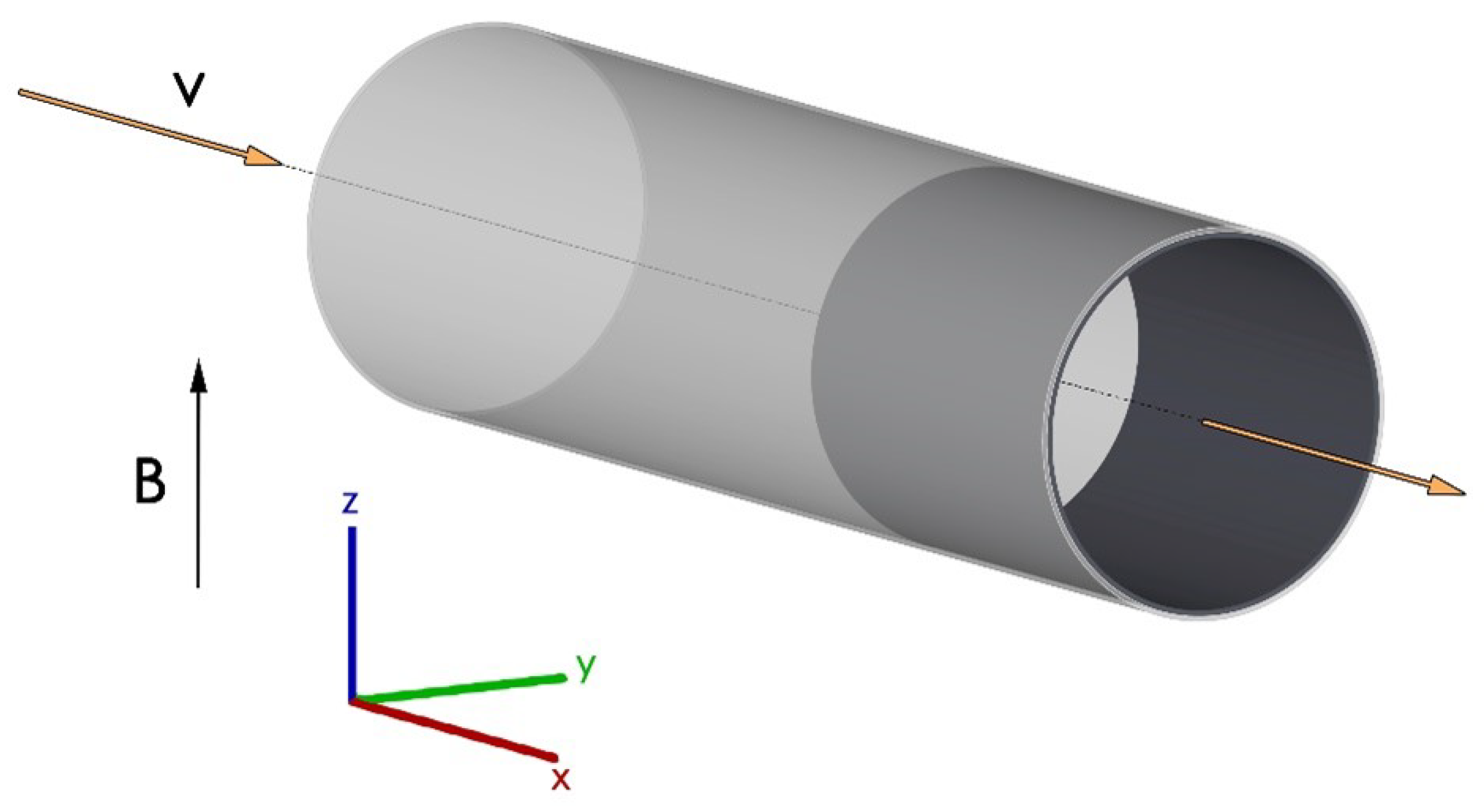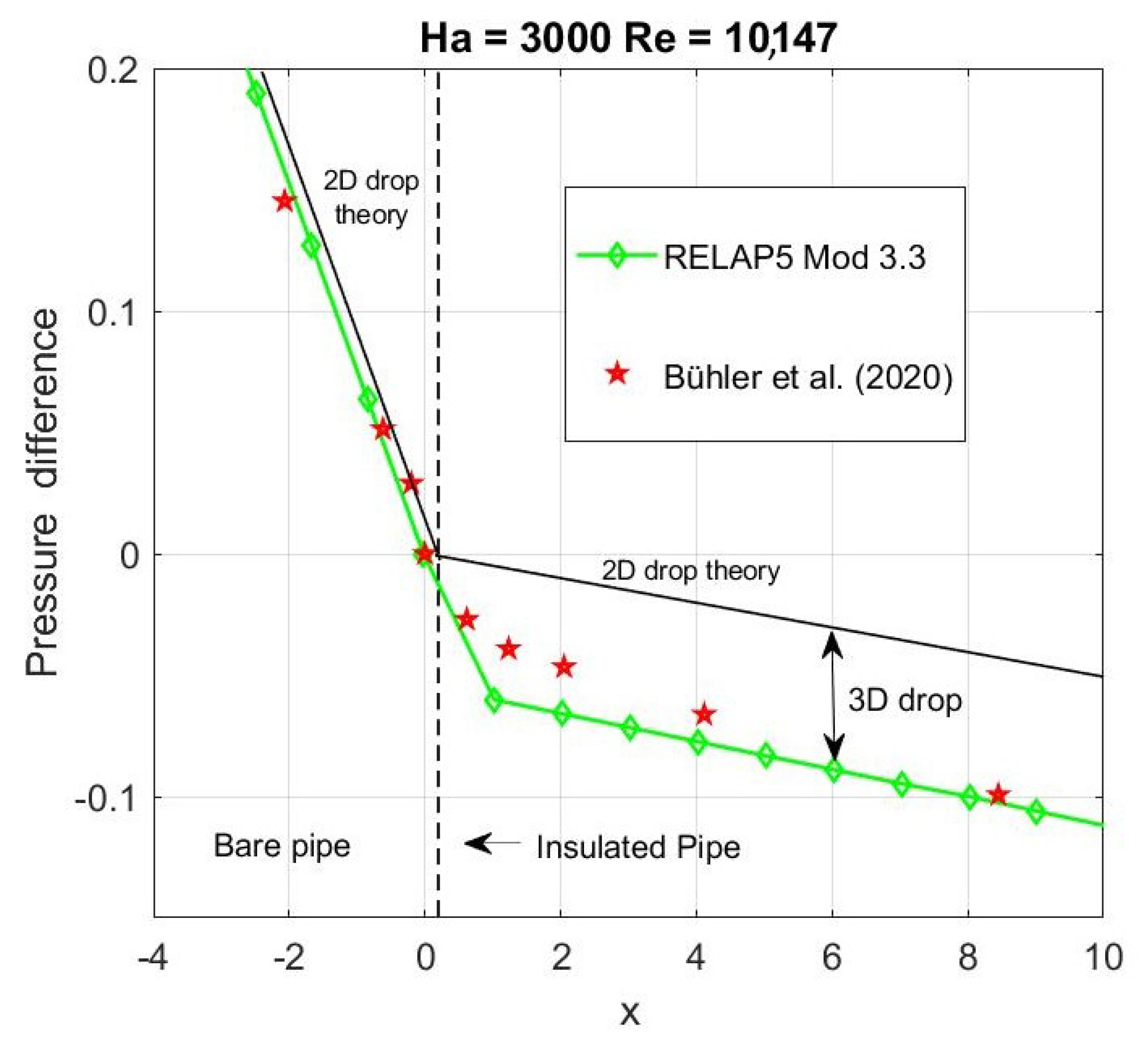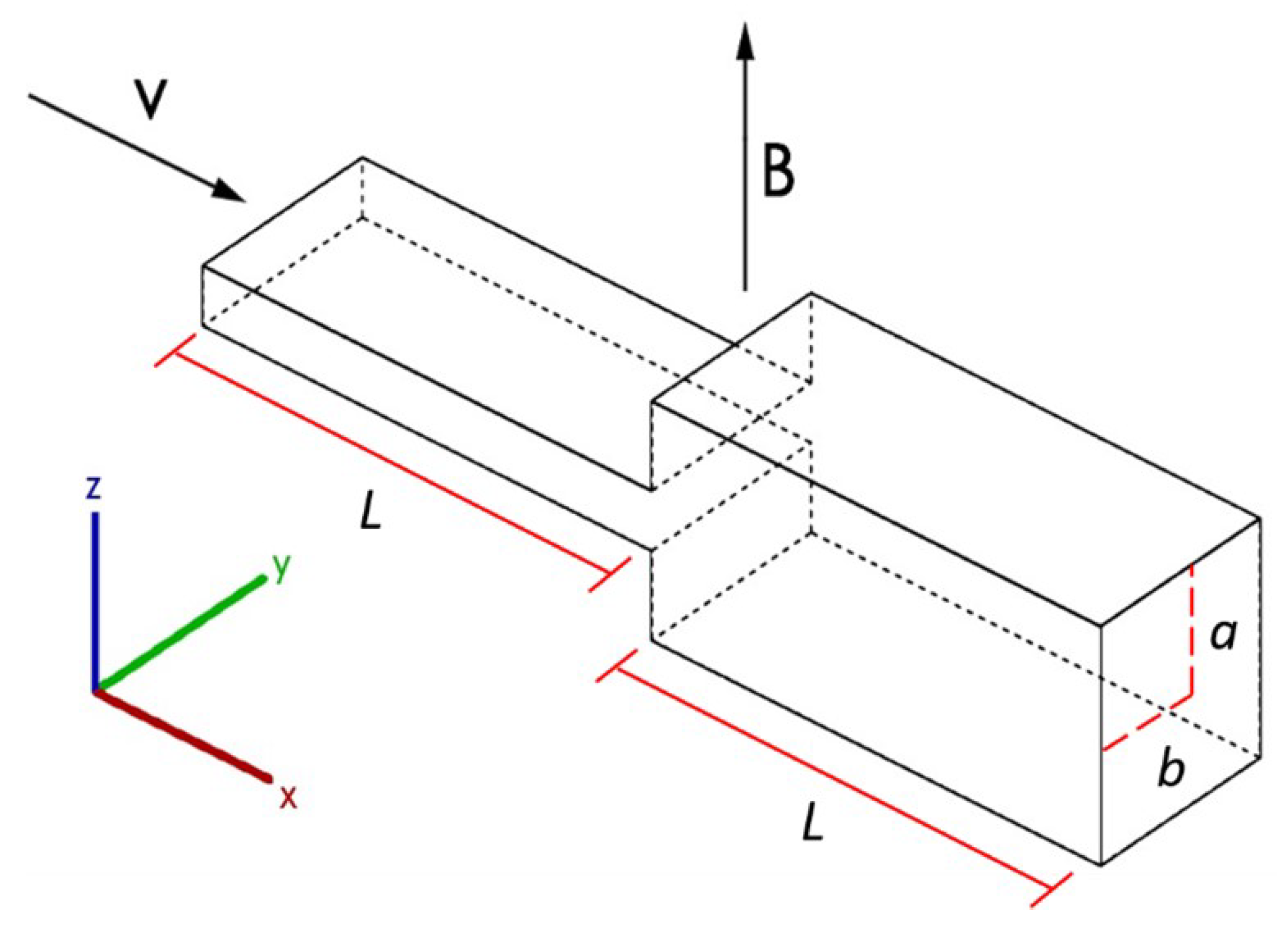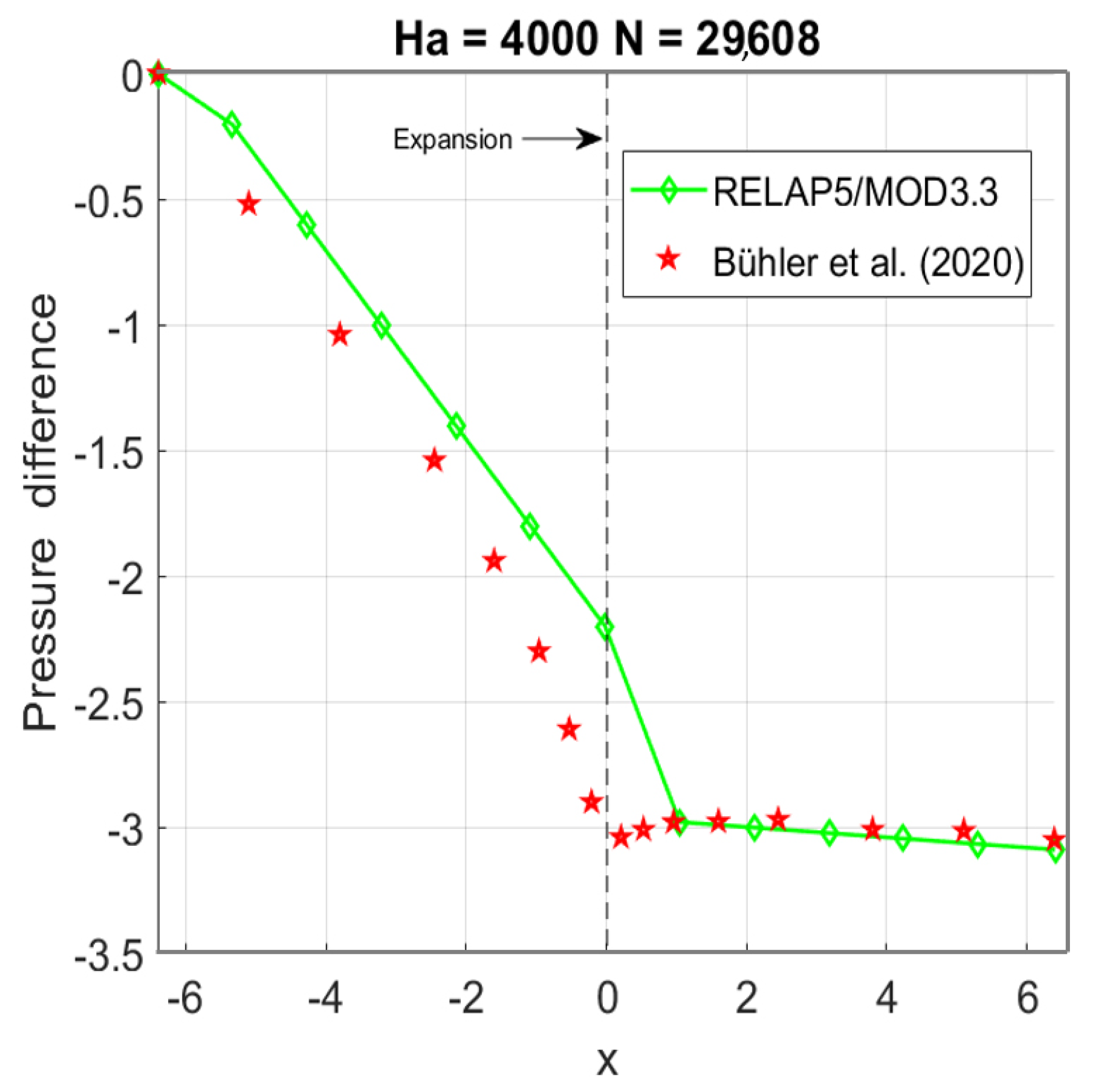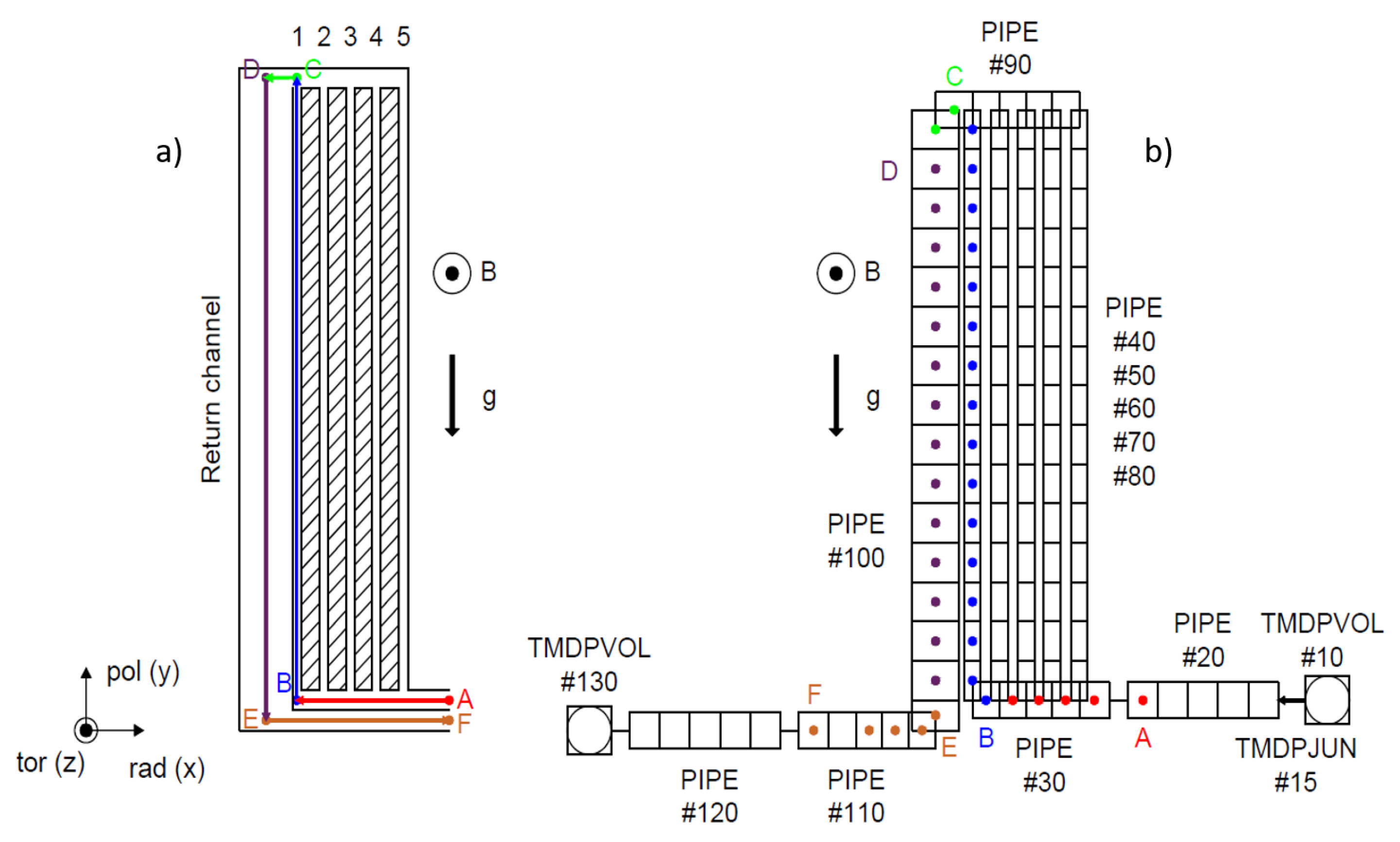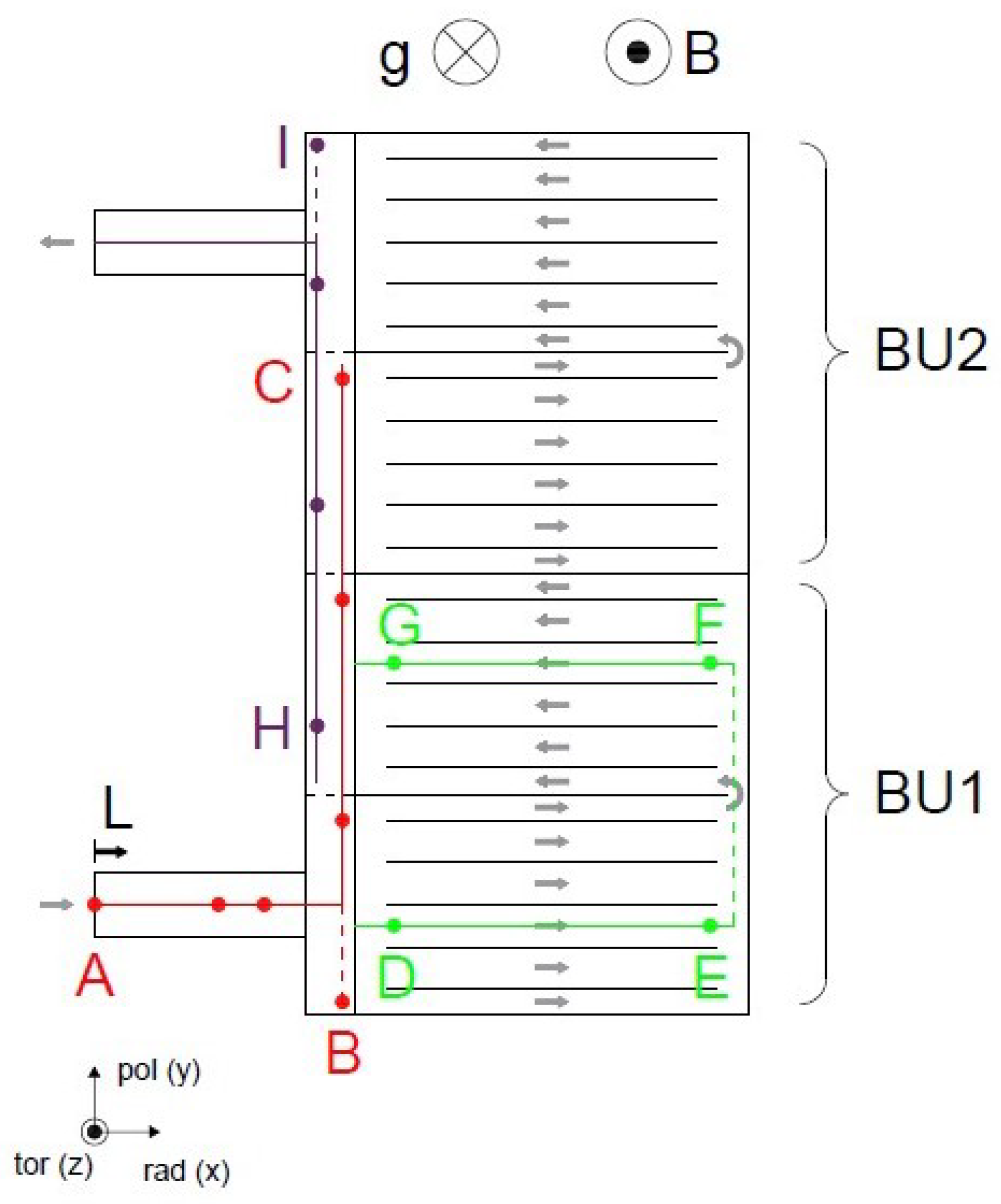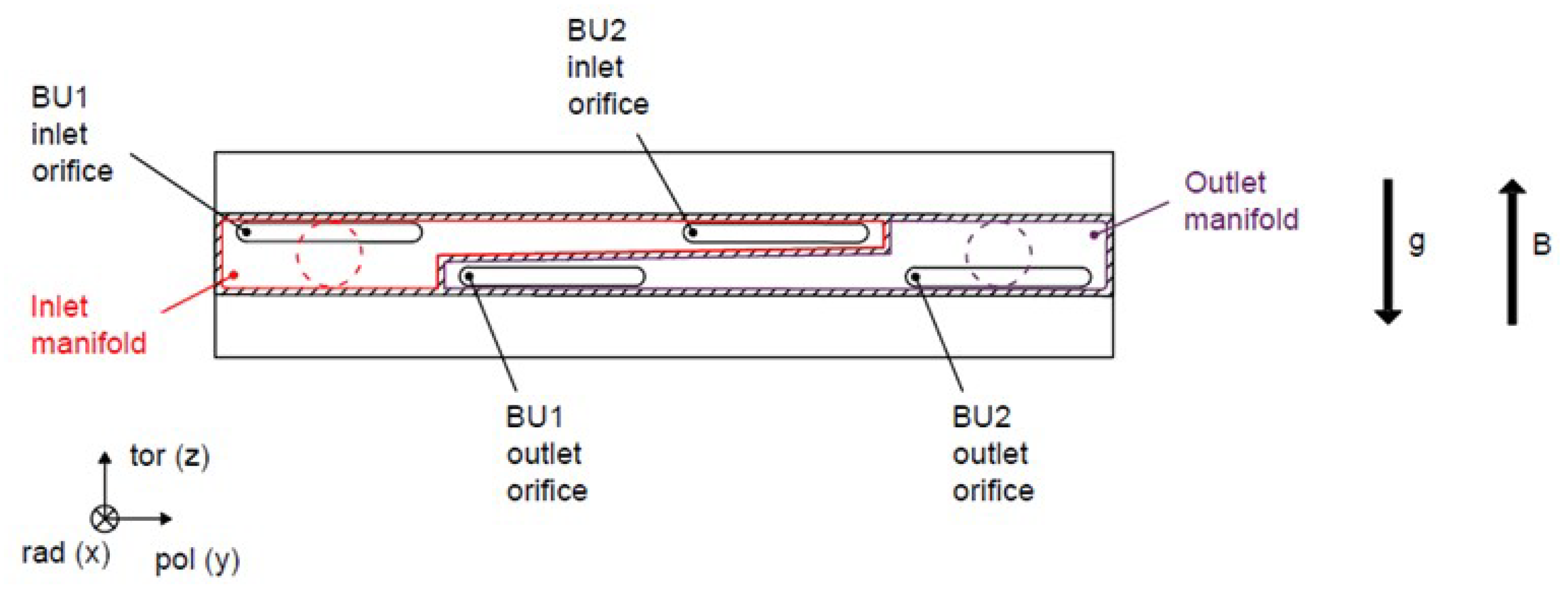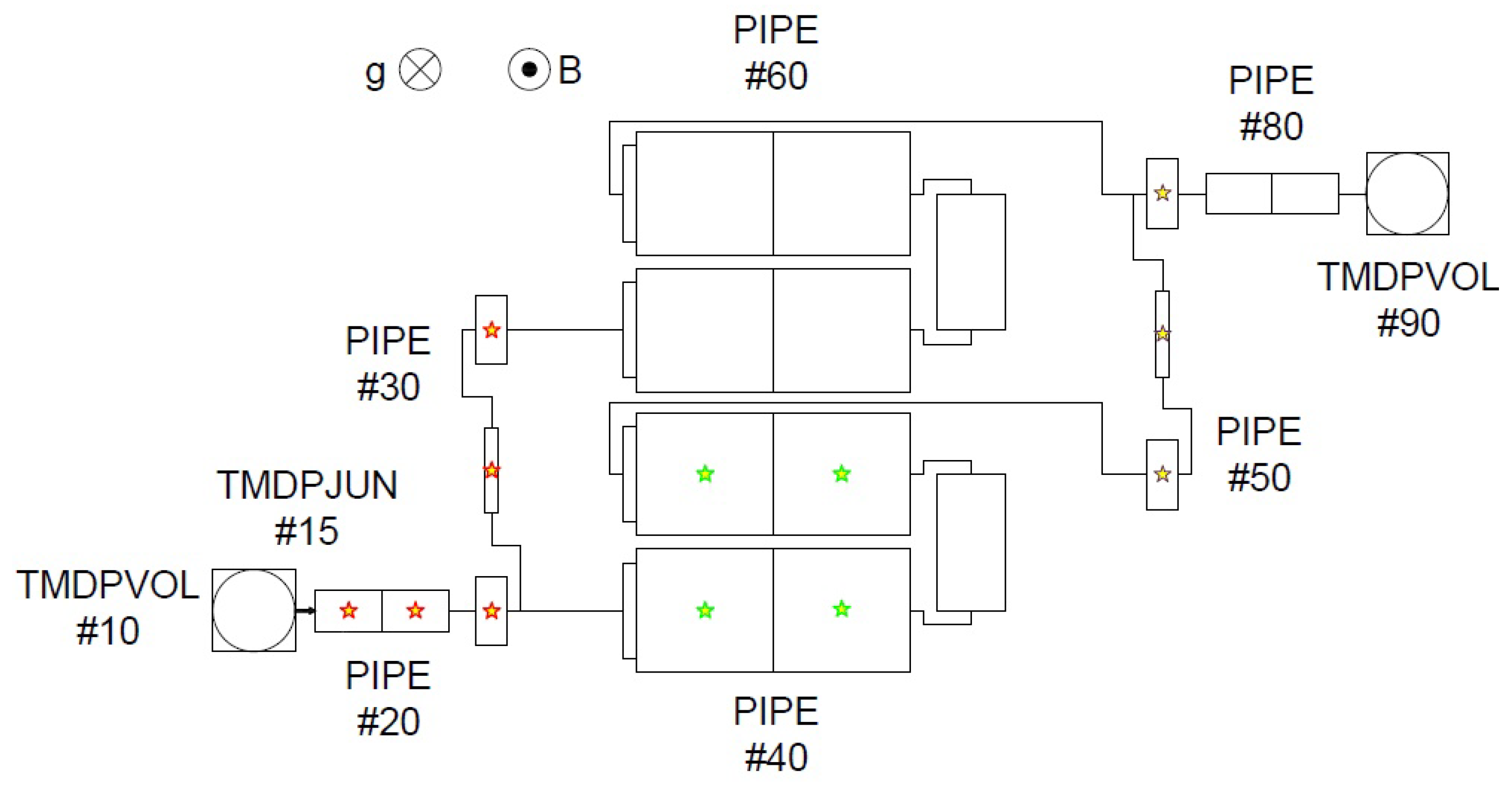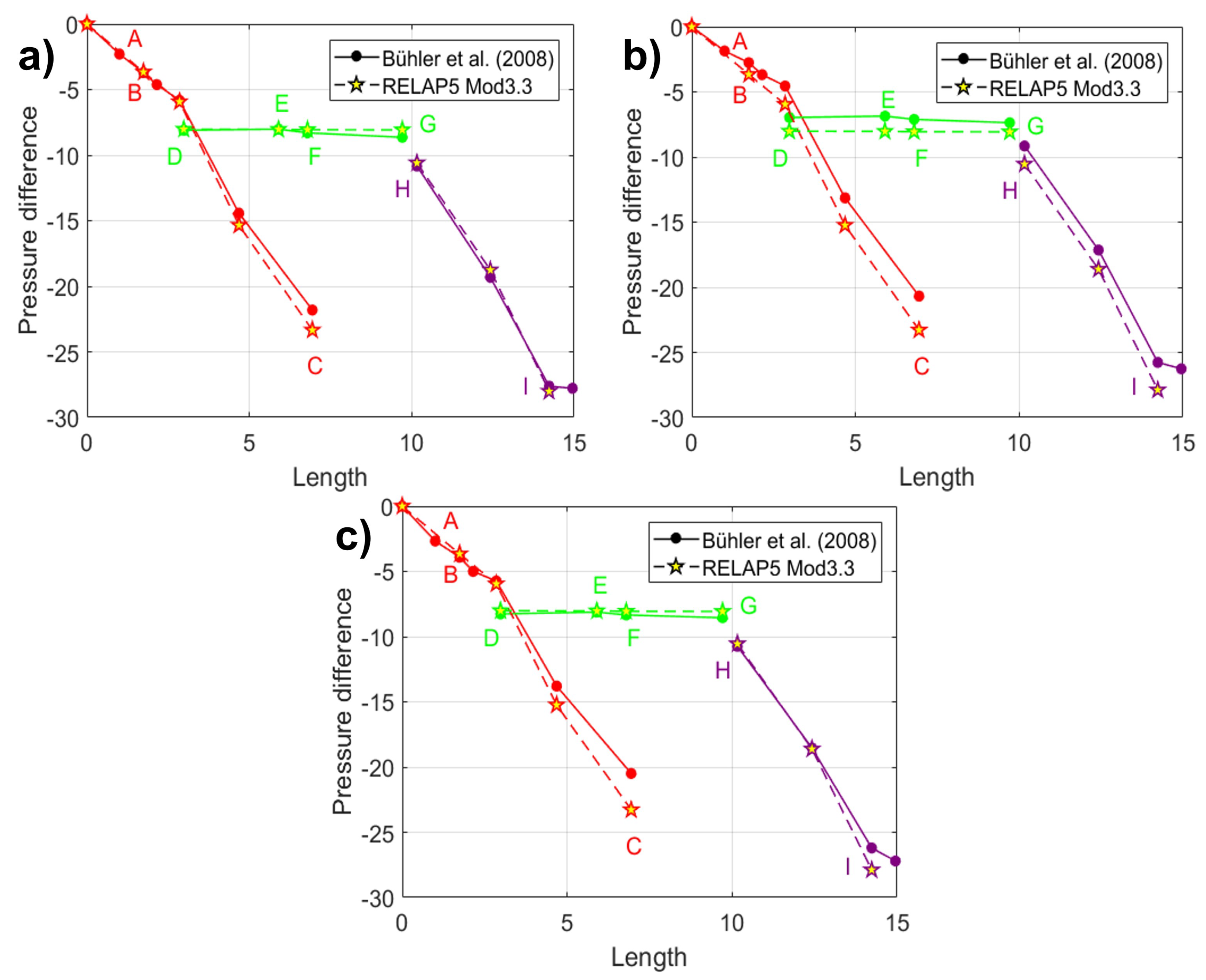4.2.1. Lithium Lead Ceramic Breeder TBM
Computational fluid-dynamic analysis of MHD flow in a full-scale variant of the proposed Lithium–Lead cooled Ceramic Breeder Test Blanket Module proposed by India for the ITER experimental campaign, has been performed, at fusion-relevant Hartmann number (
), by Swain et al. in [
51].
Numerical MHD studies at high magnetic field for such complex configurations are rare and they provide precious results for the system codes verification phase. In [
51], an exhaustive thermal-hydraulic analysis is performed; for the aim of this work, however, the attention is focused on the pressure drop outcomes.
In
Figure 10a, a two-dimensional sketch that describes the TBM geometry and flow path is represented. The LM involved is Li-Pb and enters the module through an inlet header channel (segment A-B). After that, the fluid is driven upward through five vertical (poloidal) channels (segment B-C). The poloidal channels are numbered from 1 to 5 moving away from the return channel, with Channel 1 being the closest to the latter. Consequently, the fluid is collected in top header region and then it goes down in the poloidal return channel (segment D-E). At last, the lithium-lead gathers in the outlet header (E-F) before leaving the TBM. All Li-Pb ducts have rectangular cross-section. The LM is the coolant used to extract thermal power from the breeding zone, which is constituted by boxes filled with the solid breeder (lithium-titanate) and enclosed by thin Reduced-Activation Ferritic-Martensitic steel (RAFMS) walls. For the purpose of MHD calculations, the breeder modules can be assumed as perfectly insulating and only the bounding walls must be considered to estimate the equivalent wall conductivity. Geometrical parameters are consistent with those reported in [
51], and are collected in
Table 8. Thermo-physical properties of RAFMS and Li-Pb are evaluated at the reference temperature of 623 K and the flow is assumed to be purely isothermal. Magnetic field
B is set at 4 T and assumed to be unidirectional and aligned with the toroidal axis. Mass flow rate imposed at the inlet is equal to 12 kg/s.
The nodalization scheme, developed on the geometry presented in
Figure 10a, is reported in
Figure 10b. It is composed of 118 control volumes and 121 hydraulic junctions. The sliced modelling approach is applied, assuming the same length for the vertically oriented volumes at the same level. Inlet conditions of the liquid metal are imposed by a time-dependent volume (TMDPVOL # 10) and a time-dependent junction (TMDPJUN # 15). The TMDPVOL sets Li-Pb inlet temperature and the TMDPJUN imposes the liquid metal mass flow rate. The Li-Pb outlet pressure is fixed by an additional time-dependent volume (TMDPVOL # 130). All the sections composing the TBM have been modelled with equivalent pipe components. The modelling approach is to keep actual inventory and flow area for each section. Hydraulic k-loss coefficients for abrupt area changes, bends and tees have been evaluated using the correlations presented in Idel’chik handbook [
52] and are used to obtain a reliable figure for the ordinary hydrodynamics. The coloured markers in
Figure 10b (refer to the online version of the paper) identify the acquisition points of the pressure within the model. The same colours are associated with the characteristic hydraulic elements reported in
Figure 10a: red (inlet header), blue (poloidal channel), green (top header), purple (return channel), orange (outlet header). The differential pressure for the i-th control volume is evaluated as follows:
, where
is the pressure acquired in the i-th control volume,
is the pressure acquired in the
F position,
is the Li-Pb density,
g is the gravitational acceleration and
is the elevation difference between the i-th control volume and the
F level.
Before the main numerical campaign, a purely hydrodynamic simulation, imposing
B = 0 T, is performed in [
51] to quantify the weight of magnetohydrodynamic effects over inertial and viscous ones. The same simulation is repeated with RELAP5 to assess the efficacy of the geometrical and nodalization model chosen. Excellent results, in terms of mass flow rate distribution in vertical channels, are obtained with the code; the discrepancy from the numerical analysis is lower than 3.7% in each channel. In
Table 9, the comparison is summarized. As a reference, the pressure loss in the hydrodynamic LLCB TBM is estimated at 0.432 kPa, approximately 1.2% of the pressure loss estimated by the MHD model.
Once the input geometry is proven efficient, the calculation with
is carried out. Reference governing parameters are
= 17,845 and
; the characteristic length is the toroidal half-length of the whole module, namely
a = 0.214 m. In
Figure 11, it is reported the dimensional pressure drop versus axial length, occurring in the fluid path that is underlined with coloured segments in
Figure 10a. It can be noticed that RELAP5 accurately predicts the total pressure drop, with a relative error that is
. It is worth reminding that magnetic field is always directed perpendicular to the blanket module. Therefore, this calculation demonstrates that the 3D MHD models implemented for bends and cross-section variations occurring perpendicular to
B are reliable to simulate even a complex geometry like the one considered in this study.
Nevertheless, it is important to point out a significant shortcoming of our code. As mentioned, RELAP5 is not currently capable of recreating electromagnetic coupling effects, like the ones that exist in the LLCB due to the sharing of an electrically conductive wall between Channel-1 and the return channel. The lack of this feature is made quite noticeable by the huge difference that is found between the RELAP5 and CFD predictions of the mass flow rate distribution across the TBM vertical channels, as it is shown in
Table 10.
According to Swain’s CFD calculation, the presence of electromagnetic coupling phenomena accentuates the imbalance of mass flow rate in poloidal channels, that in the OHD case is due to inertial forces only. As a matter of fact, the numerical pressure gradient of Channel-1 is significantly decreased by local electrical coupling effects due to its adjacency with the counter-flowing return channel that, assuming uniform flow distribution, carries as much as five times its flow rate. A qualitative explanation, cfr.
Figure 12, can be given as follow. Due to the electrical contact between the two channels, currents generated in one can leak and close through the other. Since
, the currents induced in the return channel are stronger in magnitude than those in Channel-1, due to the larger flow rate there. When these currents close through Channel-1, they promote the fluid movement rather than opposing it, as they would have in their original conduit, since
. Velocity increases in Channel-1 until the resistive Lorentz force generated by currents induced in is enough to compensate the leakage currents.
The macroscopic effect is that Channel-1 draws more flow rate than the other poloidal channels, from which the flow imbalance observed by Swain et al. in [
51]. Furthermore, counter-flow coupling effects influence also the flow in the inlet and outlet header where a substantial flow rate difference exists, in particular, in the region close to Channel-1 and Channel-2. This behaviour further favours a net decrease of the resistance offered by the route through Channel-1 (and, to a lesser degree, Channel-2). It is worth noticing that, instead, electro-coupling does not radically affect poloidal channels 3–5, since they are divided by solid breeder modules.
Aforementioned phenomena cannot be modelled by RELAP5 that, therefore, is going to compute the flow distribution across the poloidal channels exclusively according to the 2D and 3D pressure losses occurring therein. Inertial effects are almost negligible at
and
and, consequently, the result is an almost uniform flow distribution. Differently put, the main source of mass flow rate disequilibrium in hydro-dynamic calculation (inertia), is completely overcome by magnetohydrodynamic effects that, anyhow, are significantly affected by electromagnetic coupling in this specific configuration. It can be concluded that in its current state RELAP5 MHD module is not suitable to estimate the flow rate distribution in a manifold featuring one or more channels in electrical contact with an adjacent-counter-flowing duct with a very large flow rate. Nevertheless, it should be highlighted that the feature that the code is currently lacking, seems to not affect the pressure drop calculation in this configuration significantly, as can be observed by the results reported in
Table 11, which surprisingly match quite well the prediction from the CFD code. A possible explanation of this unintuitive behaviour is provided in the following.
The major part of the overall pressure drops of the TBM, more than 50%, takes place in the return channel as is shown in
Table 11. This happens because in the return channel the velocity is larger than the one in the poloidal ascending conduits and the expansions/contractions contributions are more important. Conversely, the effect of electrical coupling within the descending channel is weak (negligible), as it is also highlighted by the results of Swain et al. (Table 4 in [
51]), where the numerical pressure gradient is observed to be very close to the theoretical one (which, of course, neglects coupling). Consequently, RELAP5 is able to compute consistently the “leading” pressure drop source within the whole TBM. Moreover, it is important to keep in mind that electrocoupling primary decreases distributed pressure losses (2D MHD), which are linearly dependent by the the fluid mean velocity. On the other hand concentrated drops (3D MHD), that are also linear with velocity, are not significantly affected by the coupling. The good agreement in terms of total pressure drop in the poloidal Channel-1 between RELAP5 and CFD computation (see
Table 11), despite a substantial mass flow rate difference, could be due to an overall compensation of 2D and 3D MHD losses (referring to the relations expressed in Equations (
1) and (
2)). In [
51], 2D MHD drops are reduced by coupling, whereas 3D MHD ones are increased due to the high mean velocity in the conduit; RELAP5 numerical model instead provides higher MHD distributed losses since the coupling is not taken in account but the local MHD drops are less influential considering the moderate average fluid velocity. However, it is crucial to underline that this discussion is strictly valid only for the specific geometrical configuration of the LLCB TBM, since electrocoupling phenomena deeply depend on multi-channel arrangement.
To summarize, the MHD module of RELAP5 has demonstrated the capacity to provide results which are consistent with the prediction from a direct numerical simulation code in terms of electromagnetic pressure loss. A lack of fidelity is highlighted in the estimate of mass flow distribution for a manifold feeding channels which are in electrical contact with adjacent counter-flowing ducts with large flow rates. This is caused by the absence of a dedicated electromagnetic coupling model.
4.2.2. Helium Cooled Lithium Lead TBM Mock-Up
MHD flow in a scaled mock-up of a Helium Cooled Lithium Lead test blanket module for ITER has been experimentally investigated by Bühler et al. in [
33] to gather experimental data to support the proposed design concept and as a benchmark for validation of numerical tools. As one of the few experimental campaigns involving a geometry representative of the complexity of a fusion reactor blanket design, this benchmark is considered the most suitable to demonstrate the validity of the numerical approach adopted by RELAP5. The HCLL mock-up is scaled down by a factor of 2 compared with the TBM to fit into the experimental facility MEKKA. Experimental data have been collected in a wide range of parameters:
and
.
The fluid adopted for the experiment is NaK, whereas the structural material is stainless steel. Thermo-physical properties of involved materials are taken at the operating temperature of 293 K (see
Table 3). The HCLL geometry is very complicated and the fluid undergoes numerous bends and sudden cross-section variations. A two-dimensional scheme of the flow path is depicted in
Figure 13. The mock-up encompasses two parallel breeding units (BUs), each one being composed by an inflow unit (D-E) and an outflow unit (F-G). Liquid metal enters the TBM at position A, which corresponds to the beginning of the feeding pipe (with circular cross section). After, it is collected in the inlet manifold, that serves to distribute the flow rate in the two breeding units. The manifold is composed by a tall and narrow rectangular duct realized between the BU back plate and the mock-up external plate (
Figure 14). The connection with the feeding pipe is realized in a larger cavity that undergoes a sudden contraction of about 50% in the magnetic field direction at the height of the first dashed line in
Figure 13. The narrower conduit conveys the fluid to the second BU and it is gradually tapered to 50% of its original cross-section until the third dashed line in
Figure 13. The geometry of the outlet manifold mirrors the previous one: gradually increasing cross-section, sudden expansion and connection with the draining pipe. It should be noted that helium manifolds, that will reduce the available cross-section for the LM in its manifold, were not included in the mock-up and they are, similarly, not included in RELAP5 [
33]. The interface between manifold and BUs is ensured through an elongated narrow orifice in the BU back plate. Once inside the inflow unit, the fluid is subjected to another subdivision due to the presence of thin metal plates that partitions the volume in 6 parallel channels, simulating the presence of helium cooling plates. At the first wall (FW), the liquid meets an elongated and narrow toroidal-radial orifice that allows hydraulic connection with the outflow unit. The LM is then gathered in the outlet manifold and leaves the TBM through the draining pipe [
33]. In
Table 12, are gathered the dimensions of the mock-up.
The nodalization scheme adopted is reported in
Figure 15. Two time-dependent volumes define the inlet temperature and the outlet pressure of the NaK alloy. The liquid metal mass flow rate is imposed by the time-dependent junction, connecting the inlet TMDPVOL and the inlet conduit (PIPE #20 in
Figure 15). Inlet and outlet manifolds are simulated with two equivalent pipes. Each one is composed of three control volumes (CVs), reproducing the relevant configuration of the component. Focusing on the inlet manifold, the first and the third CVs simulate the inlet chambers, adjacent to the first interface between manifold and breeding units. The second CV reproduces the connection between those. For the first and the third control volumes, the flow along the radial direction is selected. This approach allows to estimate the actual abrupt area change in the interface with the breeding zone (BZ). The two BUs are simulated with two pipe components. The six channels composing the BU are collapsed in an equivalent single pipe, characterized by total flow area, equivalent hydraulic diameter and geometrical parameters relevant for MHD analysis of a single representative channel, namely one of the four at the centre of the cell. Each pipe component consists of seven CVs, reproducing inlet and outlet holes, the radial channels and the inversion chamber. Coloured markers, in both
Figure 13 and
Figure 15, mark the position of pressure acquisition data points within the mock-up and RELAP5 numerical model.
Figure 16 shows the comparison between experimental and RELAP5 data for nondimensional pressure drop along the flow path A-I (i.e., coloured lines in
Figure 13) with respect to the pressure measured in point A. the characteristic length chosen is the toroidal half-length of BU, namely
a = 0.045 m, whereas pressure is scaled with
Pa. As for cases previously studied, the pressure scaling employed allows, for a single Hartman number investigated, to condense the results for various Reynolds numbers in a unique representation. Furthermore, it confirms that MHD flows at fusion conditions are not affected by relevant inertia phenomena. For this reason, only few results are reported in graphical form.
As can be observed, pressure drop mostly occurs in the circular inlet conduit (A–B) and in the inlet/outlet manifolds (B–C and H–I), since the velocities here are much higher than in BUs due to the smaller cross sections. Moreover, the walls of pipes and manifolds are thicker, hence their wall conductance ratios generally increased compared with the ones in breeder units (). Those features provide higher currents and, therefore, more intense Lorentz forces causing greater pressure head losses. Furthermore, additional contributions to pressure loss occur because the fluid is forced to pass through narrow orifices into and out of the breeder units (B–D and G–H). Here, three-dimensional MHD effects arise and induce an additional pressure drop. The contraction (and the following expansion) of the fluid into the narrow gap between inflow/outflow units (dashed line E–F) and the bend at the first wall, have no substantial effect on the loss of load, since they occur in a plane perpendicular to B. It is noticed that the pressure loss in the breeding cells (D–E and F–G) where the fluid has a moderate velocity (≈1 mm/s) is negligible, especially when compared with the one occurring in pipes/manifolds.
RELAP5 shows an excellent agreement with experimental results. In
Table 13, as example, outcomes and relative errors for two the calculations performed at
are reported. In general, is observed an excellent prediction of the total pressure loss, with a discrepancy that is
. This is a crucial result, since it clearly demonstrates that RELAP5 is suitable to predict pressure losses even in relatively complex geometries as the one proposed for the HCLL TBM.
As discussed for LLCB, the main drawback of the code in the current version is the lack of modelling for electromagnetic coupling, which is the main source of error of RELAP5 calculation. In [
33], electrical coupling effects are demonstrated to be influential in the flow rate distribution, in particular among internal channels of BUs. Nevertheless, the pressure drop is significantly reduced in the breeding unit, thus the lack of a coupling model in the code does not essentially influence the prediction of pressure loss. It should also be noted that the code slightly over-predicts the pressure loss due to the cross-section variations; this is particularly evident in the connection between manifold and breeding unit (B–D and G–H). This is a consequence of the conservative assumptions adopted for the development of the 3D pressure loss model for this component; the estimate is likely to improve once more data will be available to fine tune it. As a final note, it is worth mentioning that the lower accuracy that the code shows for results at
could be attributed to an anomaly related to experimental data acquisition, considering that RELAP5 performance is substantially the same for
and
.
